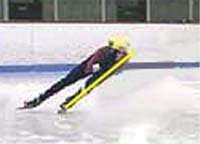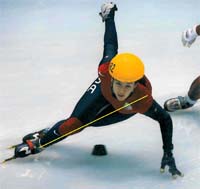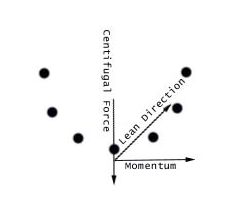Punching Through Centrifugal Force – Position and Alignments
By Susan Ellis, February 2005
The tip on The Corner Lay In – December 2004 talked about the importance of a good corner lay in to accelerate your weight forward and in to the turn to counteract the initial effects of centrifugal force. As you skate through the turn you must maintain your ideal body position and alignments, correct foot placement, and lean in order to counteract the force pushing you out, and to create the forward momentum to increase, rather than lose speed on the exit. Think of centrifugal force as a wall you must punch through to get to the other side. If any one of the above factors is missing you will hit that wall and it just may knock you on your butt.
Ideal body position
This means a position that allows your weight to easily come forward to the ball of the foot to load your push. A common error is for the chest to be too high, causing you difficulty to bend your ankle, resulting in your weight being back on your heels. If you try to get too low (less than 90 degrees through the knees) you will again have difficulty bending your ankle and shifting your weight forward. For every skater, there is an ideal skating position. This position depends on body type. For some skaters with a long torso and short legs it may mean you have to carry your upper body a little higher but can be 90-95 degrees through the knee angle. For short torso, long legged skaters it may mean you can have your upper body a little lower, but be a bit higher through the knee angle (95-110 degrees).
One way to find your ideal body position is to lean against a chair on your left leg with your right leg extended, start with your weight mid-foot on the outside part of your foot, bend your left ankle and feel if your weight comes forward to the outside ball of your foot. If it doesn’t, then adjust your upper body and/or knee angle a little at a time until you feel your weight come forward. Be careful not to hip dip (see Hip Dip – January 2004) as you do this and remember to keep your butt tucked.
Foot Placement and Alignments
Foot placement and body alignment is one of the most important factors in being able to project your weight forward so you can punch through the force pushing you out on the exit. In order to punch through at top speeds your body must be in the perfect alignment to propel your body through it.
On the corners your skate should land with your weight mid-blade, your ankle then bends more to bring your weight forward to the outside ball of the foot and the pressure stays under the ball of the foot all the way through the push. When your left foot is placed correctly on the ice, so that your weight is mid-blade and you have a straight line going through your LEFT ankle, LEFT knee, LEFT hip, and LEFT shoulder, your ankle will easily bend to bring your weight to the ball. This is your straight line of force that helps you to keep punching through centrifugal force. A common problem on the corner is overstepping. Overstepping takes away from the immediate lean and the pressure that can be exerted in to the ice.
Lean against a chair again (don’t get too low), with your weight mid-foot and your right leg extended. Your center of gravity (belly button) should be well to the inside of your left hip, knee, and ankle. Bend your ankle and feel your weight go to the ball. Now to feel the effect of an overstep, move your left foot so it is directly under your left hip and try to bring your weight forward to the ball. Ah, ha!
So when you place your left foot on the ice, place it in a position fairly close to your right skate with the LEFT ankle, LEFT knee, LEFT hip, and LEFT shoulder in line.
Ideal body position
This means a position that allows your weight to easily come forward to the ball of the foot to load your push. A common error is for the chest to be too high, causing you difficulty to bend your ankle, resulting in your weight being back on your heels. If you try to get too low (less than 90 degrees through the knees) you will again have difficulty bending your ankle and shifting your weight forward. For every skater, there is an ideal skating position. This position depends on body type. For some skaters with a long torso and short legs it may mean you have to carry your upper body a little higher but can be 90-95 degrees through the knee angle. For short torso, long legged skaters it may mean you can have your upper body a little lower, but be a bit higher through the knee angle (95-110 degrees).
One way to find your ideal body position is to lean against a chair on your left leg with your right leg extended, start with your weight mid-foot on the outside part of your foot, bend your left ankle and feel if your weight comes forward to the outside ball of your foot. If it doesn’t, then adjust your upper body and/or knee angle a little at a time until you feel your weight come forward. Be careful not to hip dip (see Hip Dip – January 2004) as you do this and remember to keep your butt tucked.
Foot Placement and Alignments
Foot placement and body alignment is one of the most important factors in being able to project your weight forward so you can punch through the force pushing you out on the exit. In order to punch through at top speeds your body must be in the perfect alignment to propel your body through it.
On the corners your skate should land with your weight mid-blade, your ankle then bends more to bring your weight forward to the outside ball of the foot and the pressure stays under the ball of the foot all the way through the push. When your left foot is placed correctly on the ice, so that your weight is mid-blade and you have a straight line going through your LEFT ankle, LEFT knee, LEFT hip, and LEFT shoulder, your ankle will easily bend to bring your weight to the ball. This is your straight line of force that helps you to keep punching through centrifugal force. A common problem on the corner is overstepping. Overstepping takes away from the immediate lean and the pressure that can be exerted in to the ice.
Lean against a chair again (don’t get too low), with your weight mid-foot and your right leg extended. Your center of gravity (belly button) should be well to the inside of your left hip, knee, and ankle. Bend your ankle and feel your weight go to the ball. Now to feel the effect of an overstep, move your left foot so it is directly under your left hip and try to bring your weight forward to the ball. Ah, ha!
So when you place your left foot on the ice, place it in a position fairly close to your right skate with the LEFT ankle, LEFT knee, LEFT hip, and LEFT shoulder in line.
Left leg alignment
To get a proper feel for the strong line of FORCE this alignment creates, take the same starting position on the chair, bring the pressure to the ball, and rotate your shoulders outward. That’s right – caused you to go back to your heel right? (That has the same effect, by the way, as putting your hip in, or the banana corner.) Now rotate your shoulders inward. Went to your toe? Rotate your knee outward – went back to your heel, right?
Now for the right leg placement and alignment. Because the line of force acting on your body has not changed you must again put your body in the ideal line to punch through it. Again your skate lands with the weight mid-blade and drops to the ball of the foot to push, but to create the countering line of force you MUST have your RIGHT ankle, RIGHT knee, LEFT hip, and LEFT shoulder aligned.
Now for the right leg placement and alignment. Because the line of force acting on your body has not changed you must again put your body in the ideal line to punch through it. Again your skate lands with the weight mid-blade and drops to the ball of the foot to push, but to create the countering line of force you MUST have your RIGHT ankle, RIGHT knee, LEFT hip, and LEFT shoulder aligned.
Lean against your chair again and draw a straight line up from your right ankle, right knee, left hip, and left shoulder and feel how easy it is to bend your ankle and drop to the ball of the foot. Now overstep with your right and you will see how difficult it is to come forward. Now try the rotations as you did on your left and feel the impact they have on your stability.
Lean
Leaning on the corner does not mean simply lean in to the turn but leaning so that your weight is always ahead of your pushing skate. In other words you are leaning forward as well as in. Look at the diagram and you will see that in order to punch through the force you need to lean forward as well as to the side. Setting your skate down correctly so that your weight is mid-blade and bending your ankle to bring your weight to the ball of the foot allows you to continue to accelerate your weight in the direction you want to go.
Lean
Leaning on the corner does not mean simply lean in to the turn but leaning so that your weight is always ahead of your pushing skate. In other words you are leaning forward as well as in. Look at the diagram and you will see that in order to punch through the force you need to lean forward as well as to the side. Setting your skate down correctly so that your weight is mid-blade and bending your ankle to bring your weight to the ball of the foot allows you to continue to accelerate your weight in the direction you want to go.
As you have just discovered, one of the most important keys to punching through centrifugal force is to put your body in the perfect body position and alignment to be able to accelerate your weight forward and punch through. Leaning alone won’t do it if your weight does not come forward. Staying low alone won’t do it if you can’t come forward, and coming forward alone won’t do it if your alignment is off.
Let simple physics do the work for you and you will find your speed increase, be much more stable, and with less effort.
Let simple physics do the work for you and you will find your speed increase, be much more stable, and with less effort.
Right leg alignment



